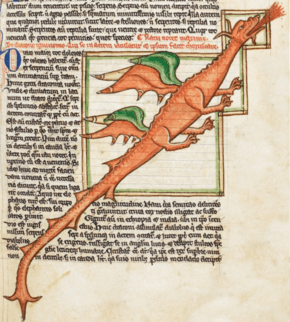List of dragons in mythology and folklore
Asian dragons
| Arabian dragons | Al Tinnin | The water reign dragon, is the arabian version of Tannin |
| Falak | A dragon or serpent of Middle Eastern legend | |
| Bahamut | A gigantic cosmic winged sea serpent and later became a dragon via borrowing characteristics from judeo-christian Leviathan and Bahamut from modern media. | |
| Armenian dragons | Vishap | Related to European dragons, usually depicted as a winged snake or with a combination of elements from different animals.[1] |
| Chinese dragons | Lóng (Lung2 in Wade-Giles romanization.) |
The Chinese dragon, is a creature in Chinese mythology and is sometimes called the Oriental (or Eastern) dragon. Depicted as a long, snake-like creature with four legs, it has long been a potent symbol of auspicious power in Chinese folklore and art. This type of dragon, however, is sometimes depicted as a creature constructed of many animal parts and it might have the fins of fish, or the horns of a stag.
|
| Babylonian dragons | Abzu | from Babylonian mythology, sometimes considered dragons. Would have been located in now present-day Iraq and Syria. |
| Marduk | Ruler of the Gods and the slayer of Tiamat, then was considered the ruler of all gods. | |
| Mušḫuššu | A creature from ancient Mesopotamian mythology found on Ishtar Gate. A mythological hybrid, it is a scaly dragon with hind legs resembling the talons of an eagle, feline fore legs, a long neck and tail, a horned head, a snake-like tongue, and a crest. Name means "reddish snake", sometimes also translated as "fierce snake". | |
| Tiamat | from Babylonian mythology, sometimes considered dragons. Would have been located in now present-day Iraq and Syria. | |
| Indian dragons | Nāga | A serpentine dragon common to all cultures influenced by Hinduism. They are often cloaked like a mongoose and may have several heads depending on their rank. They usually have no arms or legs but those with limbs resemble the Chinese dragon. Many of the Naga are more inclined towards larger snakes, not dragons.
|
Pakhangba |
A Manipuri dragon, a giant serpent that relates to humans. | |
| Vritra | Vritra, also known as "Ahi", is a serpent or dragon and is a major asura in Vedic religion. He is the personification of drought, and adversary of Indra the thunder god and king of heaven. He appears as a dragon blocking the course of the rivers and is heroically slain by Indra. The term ahi is cognate with the Zoroastrian Azi Dahaka. | |
| Tibetan Dragons | Druk | From Tibetan and Himalayan Mythology, a Dragon of Thunder similar to Shen Long in China, this Orb holding Serpentine creatures live in the remote areas of Mt. Everest and gives the storms and sun to the Tibetan people. Some say they are protectors of Shangrila. |
| Indonesian/Malay dragons | Naga or Nogo 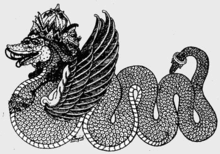 |
Derived from the Indian nāga, belief in the Indo-Malay dragon spread throughout Maritime Southeast Asia with Hinduism. The word naga is still the common Malay/Indonesian term for dragon.[4] Like its Indian counterpart, the naga is considered divine in nature, benevolent, and often associated with sacred mountains, forests, or certain parts of the sea.. In Indonesia, particularly Javanese and Balinese mythology, a naga is depicted as a crowned, giant, magical serpent, and sometimes winged. |
| Levantine dragons | Yam | the god of the sea in the Canaanite pantheon from Levantine mythology. |
| Lotan | A demonic dragon reigning the waters, a servant of the sea god Yam defeated by the storm god Hadad-Baʿal in the Ugaritic Baal Cycle. From Levantine mythology and Hebrew scriptures. | |
| Leviathan | a creature with the form of a sea monster from Jewish belief and from Levantine mythology. | |
| Japanese dragons | Ikuchi | A water dragon youkai in Japanese mythology. |
| Tatsu | Dragon of Japanese mythology, and the master of the water, like the Ryu. | |
| Orochi | the eight-headed serpent slain by Susanoo in Japanese mythology. | |
Ryū  |
Similar to Chinese dragons, with three claws instead of four. They are usually benevolent, associated with water, and may grant wishes.
| |
| Khmer dragons | Neak 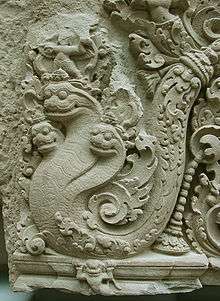 |
The Khmer dragon, or neak is derived from the Indian nāga. Like its Indian counterpart, the neak is often depicted with cobra like characteristics such as a hood. The number of heads can be as high as nine, the higher the number the higher the rank. Odd-headed dragons are symbolic of male energy while even headed dragons symbolize female energy. Traditionally, a neak is distinguished from the often serpentine Makar and Tao, the former possessing crocodilian traits and the latter possessing feline traits. A dragon princess is the heroine of the creation myth of Cambodia. |
| Korean dragons | Yong (Mireu) | A sky dragon, essentially the same as the Chinese lóng. Like the lóng, yong and the other Korean dragons are associated with water and weather. In pure Korean, it is also known as 'mireu'. |
| Imoogi | A hornless ocean dragon, sometimes equated with a sea serpent. Imoogi literally means, "Great Lizard". The legend of the Imoogi says that the sun god gave the Imoogi their power through a human girl, which would be transformed into the Imoogi on her 17th birthday. Legend also said that a dragon-shaped mark would be found on the shoulder of the girl, revealing that she was the Imoogi in human form. | |
| Gyo | A mountain dragon. In fact, the Chinese character for this word is also used for the imoogi. | |
| Persian dragons | Azhdaha | A mythical reptilian creature that derives from Persian folklore, a gigantic snake or lizard-like creatures sometimes associated with rains and living in the air, in the sea, or on the earth.[5] It is said that eating the heart of an Azhdaha brings courage and bravery. |
| Zahhak | A dragon or serpent described with three heads, and one of the heads is human.[6] However, in later text Zahhak are described a human with two snakes growing off of each shoulder.[6] Zahhak originate in old Persian and Zoroastrian mythology.[6] In some translated versions of the book Alif Laylah (One Thousand and One Arabian Nights) Zahhak is described as a giant python-like serpent having a hood like cobra.
| |
| Philippine dragons | Bakunawa | The Bakunawa, who was initially a beautiful goddess, appears as a gigantic serpent that lives in the sea. Ancient natives believed that the Bakunawa caused the moon or the sun to disappear during an eclipse. It is said that during certain times of the year, the Bakunawa arises from the ocean and proceeds to swallow the moon whole. To keep the Bakunawa from completely eating the moon, the natives would go out of their houses with pots and pans in hand and make a noise barrage in order to scare the Bakunawa into spitting out the moon back into the sky. The creature is present in Bicolano and Visayan mythologies. It is blocked by the moon goddess Haliya in Bicolano mythology, while in Visayan mythology, it is stopped by the god of death, Sidapa.[9] |
| Láwû | A serpent from Kapampangan mythology which seeks to swallow the moon, and causes lunar eclipses.[10] | |
| Olimaw | A winged phantom dragon-serpent from Ilokano mythology. It seeks to swallow the moon.[11] | |
| Sawa | A huge serpent monster from Tagalog and Ati mythologies. It attempts to swallow the moon and sun. It is blocked by the god of the sun, Apolaki, and goddess of the moon, Mayari.[12] | |
| Samal Naga | A gigantic, trapped dragon in the milky way. It is said that it will be freed and devour all those not faithful to their respective deities in Samal mythology.[13] | |
| Kanlaon dragon | A mad dragon which used to live in Mount Kanlaon in Negros Island. According to Hiligaynon mythology, it was defeated by the epic heroes, Laon and Kan.[14] | |
| Sumerian dragons | Kur | Kur, the first ever dragon from ancient Sumerian, now present-day Southern Iraq. |
| Turkish dragons | Ejderha or Evren | The Turkish dragon secretes flames from its tail, and there is no mention in any legends of its having wings, or even legs. In fact, most Turkish (and later Islamic) sources describe dragons as gigantic snakes. |
| Erenkyl | Erenkyl, the mythologic dragon of the Yakuts (Sakha). | |
| Illuyaka | Originating from Hittite mythology, a serpentine dragon slain by Tarḫunz.[15] | |
| Vietnamese dragons | Rồng or Long | The dragon is represented with a spiral tail and a long fiery sword-fin. Dragons were personified by a mother with her children or a pair of dragons. Its head and eyes are large. It has stag horns, a lion's nose, exposed canine teeth, regular flash scale, curved whiskers. Images of the Dragon King have 5 claws, while images of lesser dragons have only 4 claws.
|
European dragons
This is a list of European dragons.
| Albanian dragons | Bolla | In the Albanian mythology Bolla (also known as Bullar in South Albania), is a type of serpentic dragon (or a demonic dragon-like creature) with a long, coiled, serpentine body, four legs and small wings in ancient Albanian folklore. This dragon sleeps throughout the whole year, only to wake on Saint George's Day, where its faceted silver eyes peer into the world. The Bolla does this until it sees a human. It devours the person, then closes its eyes and sleeps again.[16] Bolla was worshiped as the deity Boa by the ancestors of Albanians, Illyrians.[17] Bolla appears in the coat of arms of the House of Bua Shpata. |
| Kulshedra | In its twelfth year, the bolla evolves by growing nine tongues, horns, spines and larger wings. At this time it will learn how to use its formerly hidden fire-breathing abilities, and is now called a kulshedra or kuçedra (hydra). The kuçedra causes droughts and lives off human sacrifices. Kulshedras are killed by Drangue, Albanian winged warriors with supernatural powers. Thunderstorms are conceived as battles between the drangues and the kulshedras. | |
| Dreq | Dreq is the dragon (draco) proper. It was demonized by Christianity and now is one of the Albanian names of the devil. | |
| Catalan dragons | Drac | Catalan dragons are serpent-like creatures with two legs (rarely four) and, sometimes, a pair of wings. Their faces can resemble that of other animals, like lions or cattle. They have a burning breath. Their breath is also poisonous, the reason by which dracs are able to rot everything with their stench. A víbria is a female dragon. |
| Chuvash dragons | Věri Şělen | Chuvash dragons are winged fire-breathing and shape shifting dragons and represent the pre-Islamic mythology, they originate with the ancestral Chuvash people.[18] |
| English dragons | Wyvern | Wyverns are common in medieval heraldry. Their usual blazon is statant. Wyverns are normally shown as dragons with two legs and two wings.
|
| Wyrm or worm | Another term for a sea serpent in Old English, these do not have limbs.
| |
| Feydragon | A unnatural dragon from the story of Lewis Carol's Alice in Wonderland.
| |
| Longwitton dragon | Of Northumbrian legend. | |
| Worm hill dragon | 700 AD the Anglo-Saxons settled and called it "Wruenele" this translates as "Wruen" worm, reptile or dragon and "ele" hill. According to local folklore the hill at Knotlow (Derbyshire) was the lair of a dragon and the terraces around it were made by the coils of its tail. Knotlow is an ancient volcanic vent and this may explain the myth. | |
| Knucker | A kind of water dragon, living in knuckerholes in Sussex, England. | |
| St. Leonard's Forest dragons | Of Sussex folklore. | |
| French dragons | Dragon
|
Authors tend often to present the dragon legends as symbol of Christianity's victory over paganism, represented by a harmful dragon. The French representation of dragons spans much of European history, and has even given its name to the dragoons, a type of cavalry.
|
| Tarasque | A fearsome legendary dragon-like mythological hybrid from Provence, tamed by Saint Martha. | |
| Germanic, Icelandic, & Scandinavian dragons | Lindworm  |
Lindworms are serpent-like dragons with either two or no legs. In Nordic and Germanic heraldry, the lindworm looks the same as a wyvern.[19]
|
| Greek dragons | Drákōn – δράκων 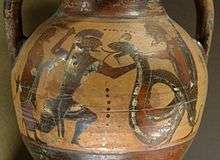 |
Cadmus fighting the Ismenian dragon (which guarded the sacred spring of Ares) is a legendary story from the Greek lore dating to before ca. 560–550 B.C. Greek dragons commonly had a role of protecting important objects or places. For example, the Colchian dragon watched the Golden Fleece and the Nemean dragon guarded the sacred groves of Zeus.[20] The name comes from the Greek "drakeîn" meaning "to see clearly".[21]
|
| Hungarian dragons | Sárkány | A dragon in human form. Most are giants with more than one head, in which their strength resides. They become weaker as they lose them.
In the contemporary Hungarian language, sárkány is used to mean any kind of dragon. |
| Zomok | A giant winged snake. It often serves as flying mount of the garabonciás (a kind of magician). The sárkánykígyó rules over storms and bad weather. | |
| Leonese and Asturian dragons | Cuélebre | In Asturian and Leonese mythology the Cuélebres are giant winged serpents, which live in caves where they guard treasures and kidnapped xanas. They can live for centuries and, when they grow really old, they use their wings to fly. Their breath is poisonous and they often kill cattle to eat. The Leonese term Cuelebre comes from Latin colŭbra, i.e., snake.
|
| Lithuanian Dragons | Slibinas | This dragon is more of a hydra with multiple heads, though sometimes it does appear with one head. |
| Polish dragons | Wawel Dragon 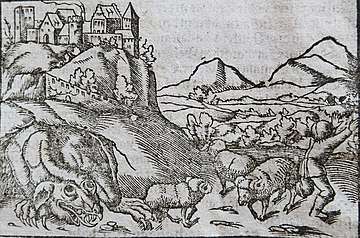 Smok Wawelski from Sebastian Münster's Cosmographie Universalis, 1544 |
Also known as Smok Wawelski, from Polish folklore, a dragon that lived in a cave on Wawel Hill on the bank of Vistula River in Kraków and was killed by a clever shoemaker's apprentice. |
| Portuguese dragons | Coca | In Portuguese mythology coca is a female dragon that fights with Saint George. She loses her strength when Saint George cuts off one of her ears. |
| Romanian dragons | Balaur, Zburator | Balaur are very similar to the Slavic zmey: very large, with fins and multiple heads. |
| Siberian dragon | Yilbegän | Related to European Turkic and Slavic dragons, multi-headed man-eating monster in the mythology of Turkic peoples of Siberia, as well as Siberian Tatars. |
| Slavic dragons | Zmey, zmiy, żmij, змей, or zmaj, or drak, or smok  |
Similar to the conventional European dragon, but multi-headed. They breathe fire and/or leave fiery wakes as they fly. In Slavic and related tradition, dragons symbolize evil. Specific dragons are often given Turkic names (see Zilant), symbolizing the long-standing conflict between the Slavs and Turks. However, in Serbian and Bulgarian folklore, dragons are defenders of the crops in their home regions, fighting against a destructive demon Ala, whom they shoot with lightning.[22][23]
|
| Tatar dragons | Zilant  |
Similar to a wyvern or cockatrice, the Zilant is the symbol of the city of Kazan. Zilant itself is a Russian rendering of Tatar yılan, i.e., snake. By the Tataro-Bulgarian mythology lived in present-day Kazan and is represented on the city's coat of arms. |
| Welsh Dragons | Y Ddraig Goch  |
In Welsh mythology, after a long battle (which the Welsh King Vortigern witnesses) a red dragon defeats a white dragon; Merlin explains to Vortigern that the red dragon symbolizes the Welsh, and the white dragon symbolizes the Saxons – thus foretelling the ultimate defeat of the English by the Welsh. The ddraig goch appears on the Welsh national flag. |
| Bheithir | In Celtic Mythology Ben Vair in Scotland takes its name from the dragon that used to live in a great hollow in the face of a mountain known as Corrie Lia. The dragon was tricked into walking along a pontoon bridge with hidden spikes. |
North American dragons
| Indigenous American dragons | Piasa Bird | A Native American dragon of Illini people. Piasa Bird is a Native American dragon depicted in one of two murals painted by Native Americans on bluffs (cliffsides) above the Mississippi River. |
| Horned Serpent | One of the most common form of native american dragons, a recurring figure among many indigenous tribes of the Southeast Woodlands and other tribal groups. | |
| Mi-ni-wa-tu | A dragon-like horned serpent of the Lakota peoples' mythology. | |
| Unhcegila | A horned serpent also of Lakota mythology. | |
| Gaasyendietha | A lake dragon or serpent of the Great Lakes, found in Iroquois and Seneca mythology. | |
| European-American Dragons | Thevetat | American esoteric cosmology and Theosophy of the 19th century. |
| Snallygaster | A tentacled dragon of appalachian Maryland, often said to be cycloptic and a hunter of black slaves. | |
| Aztec dragons | Quetzalcoatl | From Aztec mythology, has a dragon-like aspect. |
| Xiuhcoatl | a serpent from Aztec mythology | |
| Mayan dragons | Kukulkan | A Mayan mythological serpent, |
| Q'uq'umatz | From Mayan K'iche' mythology. |
South American dragons
| Brazilian dragons | Boitatá | Boitatá, Brazilian, the name comes from the Old Tupi language and means "fiery serpent" (mboî tatá). Its great fiery eyes leave it almost blind by day, but by night, it can see everything. According to legend, Boi-tatá one was a big serpent which survived a great deluge. |
| Paraguay | Teju Jagua | Teju Jagua from Guaraní mythology is described was a huge lizard with seven dog-like heads, entitled to a "fiery gaze", and being associated as the god of fruits, caves and (more common with the Dragons in Europe) as the protector of hidden treasures. |
| Inca dragons | Amaru | Dragon or (Chimera) of Inca Mythology. It had a llama's head, fox's mouth, condor wings, snake's body, fish's tail and dragon scales |
| Mapuche dragons | Ten Ten-Vilu | The serpent god of earth and fertility in traditional Mapuche religion. Part of the myth of the Legend of Trentren Vilu and Caicai Vilu. |
| Coi Coi-Vilu | The serpent god of water, and the ruler of the sea in traditional Mapuche religion. Created by the god Ngenechen from his sons after a fight he had with them. |
African dragons
| Benin dragons | Aido Wedo | The Rainbow Serpent of Dahomey mythology. |
| Egyptian dragons | Apep or Apophis | The giant Snake or Serpent of Chaos from Egyptian mythology. |
| Ouroboros | The "tail-eater" snake or serpent. | |
| Nyanga dragons | Kirimu | A dragon from the Mwindo Epic. It is described as a large animal with black hide, teeth like a dog, a huge belly, the tail of an eagle and seven horned heads. In the Mwindo Epic, it made a blood pact with Nkuba, the Nyanga lightning god.[24] |
Common dragons with unknown origin
- Azazel from the Abrahamic religions, is described as a dragon in the Apocalypse of Abraham.
- Sea serpent, a water dragon found worldwide.
- The unnamed five-headed dragon subdued by the Buddhist goddess Benzaiten at Enoshima in Japan in A.D. 552
- The unnamed dragon defeated by Saint George.
- Common Green Drakk from the Discovery of Dragons by Grahame Green, said to be the Dragons from the 18th century.
Other serpentine creatures in mythology and folklore
See also
References
- Kuehn, Sara (2011). The Dragon in Medieval East Christian and Islamic Art. Brill. pp. 29. ISBN 9789004209725.
- Sun, Xiaochun (1997). Helaine Selin (ed.). Encyclopaedia of the History of Science, Technology, and Medicine in Non-Western Cultures. Kluwer Academic Publishers. pp. 360, 517. ISBN 0-7923-4066-3. Retrieved 2019-06-10.
- "Between Buddha and naga king: Enter the yin and yang of the Swat River". The Express Tribune. 2014-08-26. Retrieved 2019-04-12.
- "dragon." kamus.net. 2010. http://www.kamus.net/result.php?w=en-usa&q=dragon&submit=Search&e=0 (29 June 2011).
- "AŽDAHĀ". Encyclopaedia Iranica. Retrieved 2019-09-04.
- Bane, Theresa (2014). Encyclopedia of Demons in World Religions and Cultures. McFarland. p. 335. ISBN 0786488948.
- Zamyād Yasht, Yasht 19 of the Younger Avesta (Yasht 19.19). Translated by Helmut Humbach, Pallan Ichaporia. Wiesbaden. 1998.CS1 maint: others (link)
- The Zend-Avesta, The Vendidad. The Sacred Books of the East Series. 1. Translated by James Darmesteter. Greenwood Publish Group. 1972. ISBN 0837130700.CS1 maint: others (link)
- https://www.aswangproject.com/creatures-mythical-beings-philippine-folklore-mythology/
- "Lauo, Serpent of the Blood Moon | Philippine Mythology". The Aswang Project. Retrieved 2019-09-04.
- "A Compendium of Creatures & Mythical Beings from Philippine Folklore & Mythology". The Aswang Project. Retrieved 2019-09-04.
- Gaverza, Karl (2018-01-27). "Sawa". Philippine Spirits. Retrieved 2019-09-04.
- "The Imprisoned Naga, An Explanation of the Milky Way | Philippine Myth". The Aswang Project. Retrieved 2019-09-04.
- "Legends of Mount Kanlaon, Negros Island, Negrense Mythology". The Aswang Project. Retrieved 2019-09-04.
- Leick, Gwendolyn (1998). A Dictionary of Ancient Near Eastern Mythology. London, England: Psychology Press. p. 85. ISBN 9780415198110 – via Google Books.
- Lurker, Manfred (1984). The Routledge Dictionary of Gods and Goddesses, Devils and Demons, Taylor & Francis e-Library. p.35
- Evans, A.; Destani, B.D. (2006). Ancient Illyria: An Archaeological Exploration. I. B. Tauris. p. 18. ISBN 9781845111670. Retrieved 2015-06-12.
- "8 Types Of Dragons You Have Never Heard Of". Listverse. 2008-06-17. Retrieved 2019-04-04.
- Rouă, Victor (2017-01-10). "Ancient Dragons In The Norse Mythology And Scandinavian Folklore". The Dockyards. Retrieved 2019-07-24.
- "Dragons of Ancient Greek Mythology THEOI.COM". theoi.com. Retrieved 2015-06-12.
- "dragon Facts, information, pictures | Encyclopedia.com articles about dragon". encyclopedia.com. Retrieved 2015-06-12.
- Зечевић, Слободан (1981). Митска бића српских предања. Belgrade: "Вук Караџић" : Етнографски музеј. (A book in Serbian about mythical creatures of Serbian traditions)
- Беновска-Събкова, Милена. "Змей". Родово Наследство. Archived from the original on 2007-12-18. Retrieved 2007-08-13. (An extract from the book Змеят в българския фолклор (The Dragon in Bulgarian Folklore), in Bulgarian)
- Biebuyck, Daniel; Mateene, Kahombo C.; Kahombo, Mateene (1971). The Mwindo Epic from the Banyanga (Zaire). University of California Press. ISBN 978-0-520-02049-8.
Further reading
- Barber, Elizabeth Wayland, and Paul T. Barber. "Fire-Breathing Dragons." In When They Severed Earth from Sky: How the Human Mind Shapes Myth, 231-44. PRINCETON; OXFORD: Princeton University Press, 2004. doi:10.2307/j.ctt7rt69.22.
- Blust, Robert. "The Origin of Dragons." Anthropos 95, no. 2 (2000): 519-36. www.jstor.org/stable/40465957.
- Stein, Ruth M. "The Changing Styles in Dragons—from Fáfnir to Smaug." Elementary English 45, no. 2 (1968): 179-89. www.jstor.org/stable/41386292.
This article is issued from Wikipedia. The text is licensed under Creative Commons - Attribution - Sharealike. Additional terms may apply for the media files.

